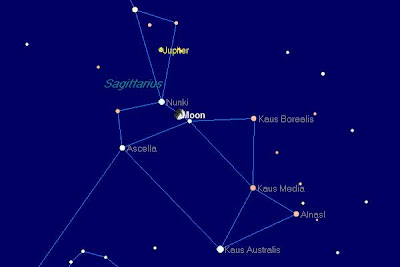Look outside about half an hour to an hour after sunset. The crescent moon will be very low in the southwest. Just to its lower right, you'll see two bright planets, Venus and Jupiter. Venus is the brighter of the pair. The two are separated by only 2°. That's about the width of your index finger held at arm's length.
Monday, December 1, 2008
Tuesday, October 7, 2008
Astronomy Tonight: The Moon and Sagittarius

Tonight the moon is to the left of Sagittarius. Look for the familiar teapot shape to the lower right of the moon. Jupiter is the brightest object to the right of the moon.
Labels:
Events
Monday, October 6, 2008
Astronomy Tonight: The Moon and Jupiter

Look for the moon in the early evening. The bright "star" to its upper right is the planet Jupiter.
Take a look at the stars surrounding the moon. They form a familiar teapot shape. This asterism is the easiest way to identify the constellation Sagittarius. The moon is in the teapot's handle.
Labels:
Events
Friday, September 19, 2008
The Moon & Pleiades

If you're up late, say 11pm or midnight, look for the moon low in the east. Immediately to its upper right is a cluster of stars known as the Pleiades. If the glare of the moon interferes with your view of this bright cluster, use your hand to block off the moon.
The Pleiades, also known as the Seven Sisters, is one of the few clusters visible to the naked eye under city skies. At least 6 stars are visible even without binoculars.
Labels:
Events
Thursday, September 18, 2008
Constellation Lyra

Vega, the brightest star in the Summer Triangle, belongs to the constellation Lyra. It's the brightest star in the constellation. At magnitude 0, it's also the fifth brightest star in the sky.
Hanging off Vega are two pairs of stars. Two of them, the brighter of the pairs, are named Sheliak and Sulafet. The four stars form a parallelogram, as shown in the chart above.
Note another star labeled the Double Double. If your eyes are sharp enough, this star appears as a double star. These stars are doubles themselves, making the Double Double a quadruple star system. A sharp telescope on a good night will show all four stars.
References:
The 10 Brightest Stars
Constellation Lyra
Labels:
Constellations
Wednesday, September 17, 2008
Constellation Cygnus

The stars of the Northern Cross belong to the constellation Cygnus, the swan. Deneb, at magnitude 1.25, is the brightest of the stars. It's also among the top 20 brightest stars in the sky.
Deneb marks the tail of the swan. In fact, Deneb is Arabic for "tail." At the opposite end is the star Albireo marking the head of the swan. Albireo is a popular among amateur astronomers because it appears as a beautiful yellow and blue double star through a telescope.
References:
List of Brightest Stars
Constellation Cygnus
Albireo
Labels:
Constellations
Tuesday, September 16, 2008
The Northern Cross

Take a closer look at Deneb, the northernmost and faintest star in the Summer Triangle. Off to the south, or the right, of Deneb are three stars. The middle star is labeled Sadr in the chart above. Farther to the south, or right, is the fainter star Albireo.
These stars make up what is known as the Northern Cross. Deneb marks the top of the cross. Sadr is at the intersection of the arms of the cross, and Albireo is at the bottom of the cross.
Deneb to Albireo spans 22°. If you hold your outstretched hand at arm's length against the sky, the width from your thumb to your little finger covers about 25°. The Northern Cross should fit within your outstretched hand.
References:
Constellation Cygnus
Star Science in the Autumn Sky
Labels:
Asterisms
Subscribe to:
Comments (Atom)
